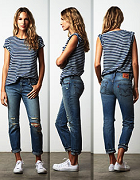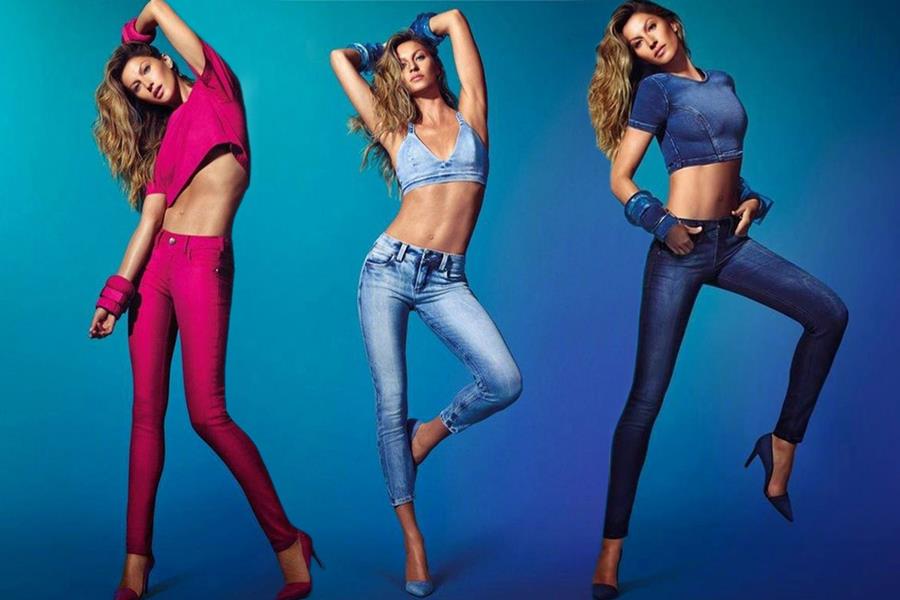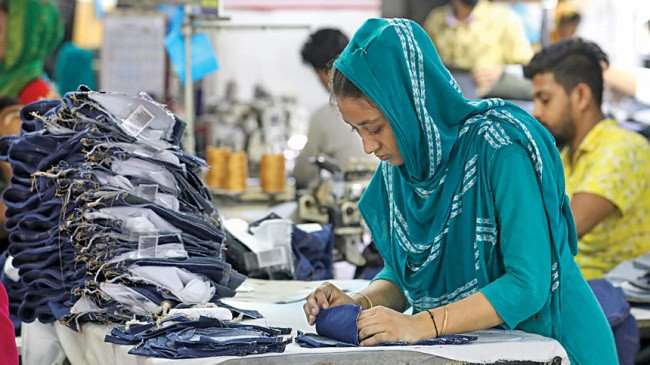FW
A $15 minimum wage slated to be implemented by 2020 may force US companies to outsource services, says a Wall Street Journal report. Los Angeles in particular, which has factories producing jeans, jackets and other apparel items employs most of the workers in the country. Manufacturers and designers feel that ‘Made in LA’ may suffer due to the impending new wage law, which would increase city’s minimum wage to $15 an hour by 2020.
Los Angeles sees more people working in garment factories than traditional business towns such as Chicago, Detroit or Philadelphia. While the number of manufacturing workers in Los Angeles and nationwide has plummeted from 25 years ago, the community has maintained its leadership position. There are about 524,000 manufacturing workers in the region, well above 409,000 in Chicago and 368,000 in New York, according to the U. S. Department of Labor figures.
The city’s wage law, which will raise the base pay by 50 per cent over five years, will surely help the working families in raising their living standards but would put a pressure on manufacturers and they may have to move out of L. A. to reduce cost burden. With manufacturers in L. A. fearing the worst, around eight cities, including St. Louis, New York and Washington, are now evaluating their proposals to raise the minimum wage to $15 an hour.
www.dol.gov
Led by the International Labour Organisation (ILO) and the government, RMG factory assessment, involving structural integrity and electrical safety inspection, may take more time to complete. Reason: RMG manufacturers have been given a couple of months more to pull up their socks. The step taken though, has not gone down well with the Inspector General of Department of Inspection for Factories and Establishments (DIFE), Syed Ahmed. Questions have been raised on the relevance of extending the deadline in a meeting held recently.
The meeting saw the presence of ambassadors from the five countries, including EU, US, Canada and the Netherlands. They too were in favour of extending the deadline. The ILO, designated to oversee the RMG factory assessment affairs, is expected to inform the BGMEA authorities soon.
The BGMEA had earlier asked for time extension from ILO on the pretext that owners will not be able to meet the deadline on account of Eid. The ILO has done this several times before. The purpose of this exercise is to implement the Sustainability Compact and progress in the RMG sector. The safety measures are the direct fallout of the collapse of Rana Plaza factory in 2013.
The Zero Discharge of Hazardous Chemicals (ZDHC) group has released a new Chemical Management System (CMS) guidance manual aimed at helping textile factories, brands, retailers and suppliers develop an in-house CMS. ZDHC feels a sound chemical management system is not only important for worker safety and to reduce environmental impacts on the community and broader environment but is a cornerstone for ensuring continuous improvement and harmonisation towards the group's zero discharge goal.
The guidance manual creates a comprehensive and pragmatic process for managing hazardous chemicals that allows an entry point for different roles in the supply chain. The manual is structured into various sections. The ‘planning’ stage involves committing to CMS as well as assessment and prioritisation. This includes an environmental audit. The ‘do’ phase involves chemicals management, the ‘check’ phase involves monitoring and the ‘final act’ stage entails management review.
In 2011, a group of major apparel and footwear brands and retailers made a shared commitment to help lead the industry towards zero discharge of hazardous chemicals by 2020. Members of the ZDHC group include Adidas, Benetton, Burberry, Esprit, Gap, H&M, Inditex, Levi Strauss, Nike and Puma and a diverse group of stakeholders.
www.roadmaptozero.com/

Coming to terms with the fact that today's women find themselves comfortable in yoga pants or athleisure than a pair of denims, Levi's has been working hard to create a yoga-pant like feel in their line of denims. Finally, the brand introduced the new women's line ‘Lot 700’, at an event in Manhattan's clubby Meatpacking District. James Curleigh, Levi's President expects the new range to boost wholesale prices over the next three years. And Macy's has already doubled the amount of space dedicated for this brand at its flagship in Manhattan as well as stores across the US.
Levi Strauss, which invented the first pair of blue jeans 141 years ago, was among the jean makers that acknowledged that their business was hurt by the ‘athleisure’ trend.
Wooing the yoga-pant generation

Levi’s knows that people simply love their denim. While the trend cycle in this category has witnessed several changes what remains intact is people’s love for the pair of jeans. However, with fit becoming an important factor for today’s fitness conscious young generation, products like yoga pants and brand offering them such as Lululemon - are surely taking over the success of denims and denim brands.
As per market research firm NPD Group while sales of the iconic blue jeans fell six per cent during 2013 in the US, after decades of almost steady growth, yoga pants and other ‘active wear’ showed a seven per cent rise, with people showing preference to yoga pants and leggings over traditional denim. Interestingly, the trend is mostly being driven by women. Sales of women's jeans in the US fell seven per cent in that period.
Taking note of this big change, Bart Sights, Levi Strauss’s Senior Director for technical innovation, along with his team has been constantly working on achieving the desired effect with denim fabric at Levi’s research and development lab at the foot of Telegraph Hill in San Francisco. Sights has been putting in effort to provide the fabric just the right amount of stretch, at the right places, while making sure that they don’t stop looking like jeans.
R&D to satisfy women, drive sales
The new technique, Sights is working on is called contouring. Sights uses lasers to remove the top layer of indigo, highlighting the centre of the leg so the inner and outer thighs appear to recede into the background, helping the leg look slimmer. The whisker patterns on the thighs are applied in a way that draws the eye away from the edge of the hips, while chevrons run along the legs to give an elongated impression. The aim is not to create yoga denim but to make jeans that are more comfortable, while retaining their 19th century essence.
The core of the newly created line is called Lot 700 that features the retro ‘Two Horse’ leather logo patch on the rear waistband and larger back pockets. Another style, Lot 300, uses a more girdle-like design for an exclusive shaping effect and another style, the 501ct can be worn in a looser fit. The skinny and midrise jeans with additional soft and stretchy material are getting a thumbs-up by women customers but there still is a long way to go before they once again give up leisurely yoga-pant styles to slip into a pair of Levi’s…
A recent report ‘Global Apparel Markets’ from business information company Textiles Intelligence, reveals world exports of denim fabric with a cotton content of less than 85 per cent tripled over five years to 2014. Consequently, it reached a record high of $1.7 billion. Meanwhile, exports of denim fabric with a cotton content of 85 per cent or more, dipped during the same period, to $2.9 billion. This shift in production of denims with cotton content of less than 85 per cent was due to a surge in prices of raw cotton in 2010 and early 2011. Thus, the share of world denim fabric exports that consisted of fabric with a cotton content of 85 per cent or more, dipped from 83.9 per cent to 62.7 per cent between 2009 and 2014. However, the share of denim fabric exports that consisted of fabric with a cotton content of less than 85 per cent rose from 16.1 per cent to 37.3 per cent.
The largest exporter of denim fabric, China, shifted to fabric with a cotton content of less than 85 per cent. This was much greater than the shift towards such fabric globally. Fabric with cotton content of 85 per cent or more consisted of only 35.2 per cent of Chinese denim fabric exports last year. Comparatively, cotton content of less than 85 per cent rose to 64.8 percent.
A change in Chinese government policy reduced the domestic price of cotton in China in the second half of 2014. Moreover, the government is set to start selling off a large portion of its stockpile, which would reduce domestic cotton prices further.
Thus, Chinese exports of denim fabric with a cotton content of 85 per cent or more, and even world exports of such fabric may rebound a bit in the coming years provided the price of raw cotton remains low.
A revolutionary flat knitting technology that allows the production of 'seam-free' knitwear was launched by Shima Seiki 20 years ago. And it was received quite well. In Italy’s Marche region some leading knitwear producers are using Shima Seiki Wholegarment knitting technology to produce top quality seam-free knitwear.
In New Esse Maglieria (NSM), a family owned knitwear manufacturer based in the Montefano town is what Italian knitwear industry calls a ‘sub-worker’or a sub-contractor who manufactures garments for another company, usually a brand or larger manufacturer. Also, there is a new breed of knitwear manufacturer in Italy that start off as sub-workers that are owned by highly skilled technicians, and, NSM is one of them.
Owner/manager Sergio Storani has some big brands under his belt. The company makes Wholegarment knitwear for women, men and children and at present about 90 per cent of its manufacturing capacity is taken up by women’s wear. It manufactures more than 2,000 pieces per week with just 11 employees. They use luxury yarns from leading Italian spinners including wool, silk, cotton and cashmere and blends.
Storani’s factory never stops working and runs 20 hours per day six days a week. He further adds that investing in Wholegarment technology has been profitable and costs reduced by around 30 per cent. Garment prices vary, but another real advantage is fit. He states that they can demand a higher price when they develop Wholegarment styles and sometimes make better profits. It all depends on the season and particular sample. He concludes that people skills, motivated workers and Wholegarment technology is the recipe for success at NSM.
Handloom weavers who are believed to have moved to Madurai from Sourashtra in Gujarat five centuries ago, and went on to become one of the most flourishing businessemen in the region, are on the verge of downfall. Modern day power looms, quick at copying designs and producing fabrics are negatively impacting livelihoods of handloom weavers in Krishnan Lane in Madurai's Chinnakanmai area.
Historians say, over centuries, people who had moved to Madurai mastered the art of handloom weaving and their skills also provided them special status in the royal courts. Even as early as the 5th century, the Gupta rulers patronized Sourashtrians because of their intricate silk weaving techniques. The arrival of the royal weavers in Madurai began with the advent of the Madurai Nayak rule in 1529, when the Vijayanagara kings established their viceroys in the region. Sourashtrians came during the time of Viswanatha Nayak but they received better patronage and flourished during the time of Thirumalai Nayak. In the same way, Tanjore Nayaks said to have patronised the community in Thirupuvanam and Tarasuram in Thanjavur district.
However, the art of weaving is now suffering at the hands of powerlooms. Even the young generation is opting for professions other than handloom weaving because of the negative impact of power looms and lack of patronage.
Karl Mayer is the world’s leading manufacturer of warp knitting machines. It continuously develops new applications and refines the technology of its machines, thus ensuring that its products are always state of the art.
The innovative delicate warp knitted tulle or net fabrics lend transparency and style to fashion as the embroidery offers a wide range of net patterns. To produce these extremely delicate creations, Karl Mayer has a high production tricot machine that ensures cost-efficient production and also a wide range of patterns. The collection of openwork net designs is based on developments at Karl Mayer, being entirely made from polyamide monofilaments.
The use of monofilaments makes it easy to process lightweight fabrics and retain their dimensional stability when stretched for embroidering. In addition, the risk of the yarn being damaged by the embroidery needle is reduced.
A remarkable feature of these textiles, compared to conventional embroidery grounds, is the soft handle with the transposed openwork structure, accounting for its extraordinary properties. Like previous collections made from monofilament yarns, the tulle patterns feature three-stitch hexagonal constructions which, in contrast to the conventional design, are characterised by holes of different lengths.
Warp knitted fabrics are used for functional swimwear and sportswear, lace lingerie and net curtains, shoes, blood vessels, ships’ hulls and babies’ nappies.
www.karlmayer.com/
Global cotton production and consumption for the 2015-16 season will dip, says a Cotton Outlook forecast. There is a reduction of nearly 600,000 metric tons in world stocks, however, most of the fall is forecasted for China. Supplies in the rest of world are envisaged to alter only marginally. Global production forecast dipped by 38,000 metric tons, due to a sharp reduction in China. However, it has been balanced by higher figures in Brazil and some African cotton producing countries. Consumption is decently low, due to the downward adjustment for the US.
According to the United States Department of Agriculture’s (USDA) report, the global cotton output for 2015-16 will dip by 6 per cent to 111.5 million bales, which is 7.5 million bales below 2014-15 and the smallest global crop since 2009-10. USDA mentions that the decrease in production is because relative prices favour alternative crop plantings for 2015-16. Global cotton harvested area in 2015- 16 is forecast at 31.8 million hectares, which is 6 per cent below previous year. World cotton yield is estimated at 764 kg/hectare, which is a little below 2014 -15. Global cotton production is supposed to remain concentrated among a few countries in 2015-16.
Nearly 79 per cent of world production will be contributed by top five cotton-producing countries for the same period. Also, India is expected to surpass China in 2015-16, as world’s largest cotton producer with a crop forecast of 29.5 million bales.
Rajasthan-based cotton yarn manufacturer Nitin Spinners has clocked in topline growth of 48 per cent with margins of around 19 to 20 per cent in Q1. Domestic business contributed around 35 per cent with the rest coming from exports.
Nitin has a combined installed capacity of 1,50,000 spindles and 3,000 rotors manufacturing 40,000 tons of yarns and threads per annum. The company has carved a niche for itself in the textile map of the country.
The fabric unit has also shown an upward growth trend since its inception. With a production capacity of 8,000 tons of fabric per annum, its top quality fabric is making its presence felt in the global textile industry. The company plans to add to its ring spinning and rotor spinning facilities. The new plant would come into operation in the second half of fiscal year ’16.
About Rs 300 crores will be spent on this project. It will be financed partly through term loans and partly through internal accruals. The expansion project is eligible for interest subsidy on term loan for capital expenditure under the Technology Upgradation Fund Scheme and the Rajasthan Investment Promotion Scheme.
www.nitinspinners.com/












